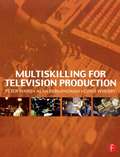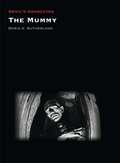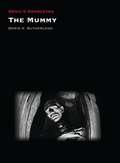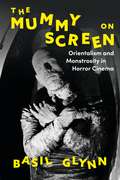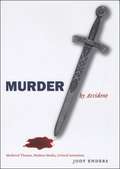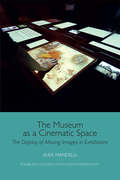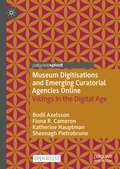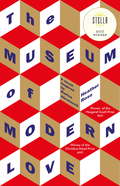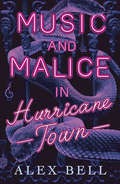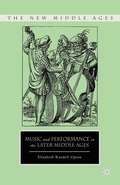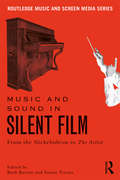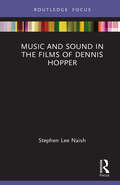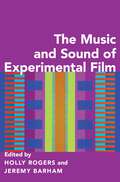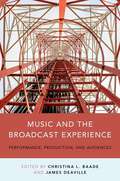- Table View
- List View
Multiplicity, Embodiment and the Contemporary Dancer: Moving Identities
by J. RocheThis book explores the co-creative practice of contemporary dancers solely from the point of view of the dancer. It reveals multiple dancing perspectives, drawn from interviews, current writing and evocative accounts from inside the choreographic process, illuminating the myriad ways that dancers contribute to the production of dance culture.
Multiskilling for Television Production
by Peter Ward Alan Bermingham Chris WherryWritten by television trainers who run their own courses on Multiskilling, this book offers a comprehensive introduction to the broad range of skills and technical knowledge required in this industry. It details all the essential information you need to know, acting as an on-the-job reference source for everyday use. For many broadcasting technicians, one of the biggest challenges in recent years has been the transition from a career working in a solo core skill such as camerawork or audio, to acquiring the experience and expertise of a range of production jobs. Many people are expected to work in a number of crafts and to equip themselves with a much wider range of television techniques than had been customary in the past.Multiskilling has become an integral part of television culture, requiring that new entrants are competent in several specialist production skills. Multiskilling for Television Production concentrates on the techniques associated with news and magazine programme production, where most tecnhical operators are usually employed, but most techniques are shared across the whole spectrum of television and film making.Anyone baffled by the range and scope of skills to be mastered will find this book invaluable.
Multiskilling for Television Production
by Peter Ward Alan Bermingham Chris WherryWritten by television trainers who run their own courses on Multiskilling, this book offers a comprehensive introduction to the broad range of skills and technical knowledge required in this industry. It details all the essential information you need to know, acting as an on-the-job reference source for everyday use. For many broadcasting technicians, one of the biggest challenges in recent years has been the transition from a career working in a solo core skill such as camerawork or audio, to acquiring the experience and expertise of a range of production jobs. Many people are expected to work in a number of crafts and to equip themselves with a much wider range of television techniques than had been customary in the past.Multiskilling has become an integral part of television culture, requiring that new entrants are competent in several specialist production skills. Multiskilling for Television Production concentrates on the techniques associated with news and magazine programme production, where most tecnhical operators are usually employed, but most techniques are shared across the whole spectrum of television and film making.Anyone baffled by the range and scope of skills to be mastered will find this book invaluable.
The Mummy (Devil's Advocates)
by Doris SutherlandReleased in 1932, The Mummy moved Universal horror away from the Gothic Europe of Dracula and Frankenstein and into a land of deserts, pyramids, and long-lost tombs. In doing so the film continued a tradition of horror fiction that is almost as old as the Western pursuit of Egyptology, as numerous European and American authors from the nineteenth and early twentieth centuries had portrayed Egypt as a place of mystery and magic. This book examines the roots of The Mummy. It shows how the film shares many of its motifs with the work of writers such as Bram Stoker, Arthur Conan Doyle, and H. Rider Haggard, whose tales of living mummies, immortal sorcerers, and Egyptian mysticism bear strong resemblances to Universal’s movie. In addition, the book discusses how The Mummy drew upon a contemporary vogue for all things ancient Egyptian: the tomb of Tutankhamun was discovered the decade before the film was released, prompting sensationalistic rumors of a curse. This is the story of what happened when Hollywood horror went to Egypt.
The Mummy (Devil's Advocates)
by Doris V. SutherlandReleased in 1932, The Mummy moved Universal horror away from the Gothic Europe of Dracula and Frankenstein and into a land of deserts, pyramids, and long-lost tombs. In doing so the film continued a tradition of horror fiction that is almost as old as the Western pursuit of Egyptology, as numerous European and American authors from the nineteenth and early twentieth centuries had portrayed Egypt as a place of mystery and magic. This book examines the roots of The Mummy. It shows how the film shares many of its motifs with the work of writers such as Bram Stoker, Arthur Conan Doyle, and H. Rider Haggard, whose tales of living mummies, immortal sorcerers, and Egyptian mysticism bear strong resemblances to Universal’s movie. In addition, the book discusses how The Mummy drew upon a contemporary vogue for all things ancient Egyptian: the tomb of Tutankhamun was discovered the decade before the film was released, prompting sensationalistic rumors of a curse. This is the story of what happened when Hollywood horror went to Egypt.
The Mummy on Screen: Orientalism and Monstrosity in Horror Cinema
by Basil GlynnThe Mummy is one of the most recognizable figures in horror and is as established in the popular imagination as virtually any other monster, yet the Mummy on screen has until now remained a largely overlooked figure in critical analysis of the cinema. In this compelling new study, Basil Glynn explores the history of the Mummy film, uncovering lost and half-forgotten movies along the way, revealing the cinematic Mummy to be an astonishingly diverse and protean figure with a myriad of on-screen incarnations. In the course of investigating the enduring appeal of this most 'Oriental' of monsters, Glynn traces the Mummy's development on screen from its roots in popular culture and silent cinema, through Universal Studios' Mummy movies of the 1930s and 40s, to Hammer Horror's re-imagining of the figure in the 1950s, and beyond.
The Mummy on Screen: Orientalism and Monstrosity in Horror Cinema (International Library Of The Moving Image Ser.)
by Basil GlynnThe Mummy is one of the most recognizable figures in horror and is as established in the popular imagination as virtually any other monster, yet the Mummy on screen has until now remained a largely overlooked figure in critical analysis of the cinema. In this compelling new study, Basil Glynn explores the history of the Mummy film, uncovering lost and half-forgotten movies along the way, revealing the cinematic Mummy to be an astonishingly diverse and protean figure with a myriad of on-screen incarnations. In the course of investigating the enduring appeal of this most 'Oriental' of monsters, Glynn traces the Mummy's development on screen from its roots in popular culture and silent cinema, through Universal Studios' Mummy movies of the 1930s and 40s, to Hammer Horror's re-imagining of the figure in the 1950s, and beyond.
Munkey Diaries
by Jane BirkinJane Birkin - actor, singer, songwriter and model - attained international fame with her decade-long musical and personal relationship with Serge Gainsbourg, which featured their internationally controversial hit song 'Je t'aime...moi no plus'. She has also enjoyed a notable career as an actress in British and French cinema, including Blow-Up, Death on the Nile and Evil Under the Sun. And then there is the Birkin bag... Throughout these years Jane has been keeping a diary:"I've been keeping a journal since I was eleven, writing it to my confidante, the stuffed monkey won in a tombola: Munkey. He has slept by my side, shared my life with John, Serge, Jacques, and been witness to every joy and sadness. Before my children arrived wreaking havoc on my life, I left Munkey in Serge's arms, in the casket where he lay, like a pharaoh. My monkey, protecting him in the after-life.As I re-read my journals, it seems obvious to me that we don't change. What I was twelve years old, I am today. Newspapers are obviously unfair, giving different versions of everything, but here, there is only my version. On principle, I haven't changed anything, and believe me, looking back, I would have preferred to have wiser reactions than I did . . ."We thought we knew nearly everything about Jane Birkin. Her book not only re-creates the flamboyant era of Swinging London and Saint-Germain-des-Prés in the 1970s, it also lets us into the everyday life of an exceptional woman.
Murakami T: The T-Shirts I Love
by Haruki MurakamiThe international literary icon opens his eclectic closet and shares photos of his extensive unique personal T-shirt collection, accompanied by essays that reveal a side of the writer rarely seen by the public. This is the ultimate gift for Murakami fans.Haruki Murakami's books have galvanized millions around the world. Many of his fans know about his 10,000-vinyl-record collection, and his obsession with running, but few have heard about a more intimate, and perhaps more unique, passion: his T-shirt-collecting habit.In Murakami T, the famously reclusive novelist shows us his T-shirts - including gems found in bookshops, charity shops and record stores - from those featuring whisky, animals, cars and superheroes, to souvenirs of marathons and a Beach Boys concert in Honolulu, to the shirt that inspired the beloved short story 'Tony Takitani'. Accompanied by short, frank essays that have been translated into English for the first time, these photographs reveal much about Murakami's multifaceted and wonderfully eccentric persona.'The world's most popular cult novelist' Guardian
Murder and the Movies
by David ThomsonHow many acts of murder have each of us followed on a screen? What does that say about us? Do we remain law-abiding citizens who wouldn’t hurt a fly? Film historian David Thomson, known for wit and subversiveness, leads us into this very delicate subject. While unpacking classics such as Seven, Kind Hearts and Coronets, Strangers on a Train, The Conformist, The Godfather, and The Shining, he offers a disconcerting sense of how the form of movies makes us accomplices in this sinister narrative process. By turns seductive and astringent, very serious and suddenly hilarious, Murder and the Movies admits us into what Thomson calls “a warped triangle”: the creator working out a compelling death; the killer doing his and her best; and the entranced reader and spectator trying to cling to life and a proper sense of decency.
Murder by Accident: Medieval Theater, Modern Media, Critical Intentions
by Jody EndersOver fifty years ago, it became unfashionable—even forbidden—for students of literature to talk about an author’s intentions for a given work. In Murder by Accident, Jody Enders boldly resurrects the long-disgraced concept of intentionality, especially as it relates to the theater. Drawing on four fascinating medieval events in which a theatrical performance precipitated deadly consequences, Enders contends that the marginalization of intention in critical discourse is a mirror for the marginalization—and misunderstanding—of theater. Murder by Accident revisits the legal, moral, ethical, and aesthetic limits of the living arts of the past, pairing them with examples from the present, whether they be reality television, snuff films, the “accidental” live broadcast of a suicide on a Los Angeles freeway, or an actor who jokingly fired a stage revolver at his temple, causing his eventual death. This book will force scholars and students to rethink their assumptions about theory, intention, and performance, both past and present.
Murder by Accident: Medieval Theater, Modern Media, Critical Intentions
by Jody EndersOver fifty years ago, it became unfashionable—even forbidden—for students of literature to talk about an author’s intentions for a given work. In Murder by Accident, Jody Enders boldly resurrects the long-disgraced concept of intentionality, especially as it relates to the theater. Drawing on four fascinating medieval events in which a theatrical performance precipitated deadly consequences, Enders contends that the marginalization of intention in critical discourse is a mirror for the marginalization—and misunderstanding—of theater. Murder by Accident revisits the legal, moral, ethical, and aesthetic limits of the living arts of the past, pairing them with examples from the present, whether they be reality television, snuff films, the “accidental” live broadcast of a suicide on a Los Angeles freeway, or an actor who jokingly fired a stage revolver at his temple, causing his eventual death. This book will force scholars and students to rethink their assumptions about theory, intention, and performance, both past and present.
Murder by Accident: Medieval Theater, Modern Media, Critical Intentions
by Jody EndersOver fifty years ago, it became unfashionable—even forbidden—for students of literature to talk about an author’s intentions for a given work. In Murder by Accident, Jody Enders boldly resurrects the long-disgraced concept of intentionality, especially as it relates to the theater. Drawing on four fascinating medieval events in which a theatrical performance precipitated deadly consequences, Enders contends that the marginalization of intention in critical discourse is a mirror for the marginalization—and misunderstanding—of theater. Murder by Accident revisits the legal, moral, ethical, and aesthetic limits of the living arts of the past, pairing them with examples from the present, whether they be reality television, snuff films, the “accidental” live broadcast of a suicide on a Los Angeles freeway, or an actor who jokingly fired a stage revolver at his temple, causing his eventual death. This book will force scholars and students to rethink their assumptions about theory, intention, and performance, both past and present.
Murder by Accident: Medieval Theater, Modern Media, Critical Intentions
by Jody EndersOver fifty years ago, it became unfashionable—even forbidden—for students of literature to talk about an author’s intentions for a given work. In Murder by Accident, Jody Enders boldly resurrects the long-disgraced concept of intentionality, especially as it relates to the theater. Drawing on four fascinating medieval events in which a theatrical performance precipitated deadly consequences, Enders contends that the marginalization of intention in critical discourse is a mirror for the marginalization—and misunderstanding—of theater. Murder by Accident revisits the legal, moral, ethical, and aesthetic limits of the living arts of the past, pairing them with examples from the present, whether they be reality television, snuff films, the “accidental” live broadcast of a suicide on a Los Angeles freeway, or an actor who jokingly fired a stage revolver at his temple, causing his eventual death. This book will force scholars and students to rethink their assumptions about theory, intention, and performance, both past and present.
The Museum as a Cinematic Space: The Display of Moving Images in Exhibitions (Edinburgh Studies in Film and Intermediality)
by Elisa MandelliMoving images have become an increasingly common feature in a wide range of museums, which are frequently populated with screens and audio-visual projections. But when did films start to be displayed in museum galleries? And what are the issues at stake when showing moving images in exhibition spaces? With an innovative and strongly interdisciplinary theoretical framework, this book offers an extensive investigation of the use of audio-visuals in exhibition design. Highlighting the continuities and fractures between different periods, contexts and practices, Elisa Mandelli shows the deep influence of audio-visuals on the configuration of the exhibition space, as well as on the relationship between museums and their visitors.
The Museum as a Cinematic Space: The Display of Moving Images in Exhibitions (Edinburgh Studies in Film and Intermediality)
by Elisa MandelliMoving images have become an increasingly common feature in a wide range of museums, which are frequently populated with screens and audio-visual projections. But when did films start to be displayed in museum galleries? And what are the issues at stake when showing moving images in exhibition spaces? With an innovative and strongly interdisciplinary theoretical framework, this book offers an extensive investigation of the use of audio-visuals in exhibition design. Highlighting the continuities and fractures between different periods, contexts and practices, Elisa Mandelli shows the deep influence of audio-visuals on the configuration of the exhibition space, as well as on the relationship between museums and their visitors.
Museum Digitisations and Emerging Curatorial Agencies Online: Vikings in the Digital Age
by Bodil Axelsson Fiona R. Cameron Katherine Hauptman Sheenagh PietrobrunoThis open access book explores the multiple forms of curatorial agencies that develop when museum collection digitisations, narratives and new research findings circulate online. Focusing on Viking Age objects, it tracks the effects of antagonistic debates on discussion forums and the consequences of search engines, personalisation, and machine learning on American-based online platforms. Furthermore, it considers eco-systemic processes comprising computation, rare-earth minerals, electrical currents and data centres and cables as novel forms of curatorial actions. Thus, it explores curatorial agency as social constructivist, semiotic, algorithmic, and material. This book is of interest to scholars and students in the fields of museum studies, cultural heritage and media studies. It also appeals to museum practitioners concerned with curatorial innovation at the intersection of humanist interpretations and new materialist and more-than-human frameworks.
The Museum of Modern Love
by Heather Rose'One of my stand-out Australian reads from 2016 . . . A glorious novel, meditative and special' Hannah Kent, author of BURIAL RITESArky Levin, a film composer in New York, has promised his wife that he will not visit her in hospital, where she is suffering in the final stages of a terminal illness. She wants to spare him a burden that would curtail his creativity, but the promise is tearing him apart. One day he finds his way to MOMA and sees Mariana Abramovic in The Artist is Present. The performance continues for seventy-five days and, as it unfolds, so does Arky. As he watches and meets other people drawn to the exhibit, he slowly starts to understand what might be missing in his life and what he must do.
Music and Malice in Hurricane Town
by Alex Bell“There are no angels in Baton Noir. Only devils.” Jude Lomax scrapes a living playing the trumpet on the neon streets of Baton Noir. Then she is invited to play at the funeral of the infamous cajou queen, Ivory Monette. Passing through the cemetery gates, Jude finds herself possessed by the murdered queen’s spirit. And Ivory won’t rest until she’s found the person responsible for her death. If Jude wants to be rid of the vengeful spirit, she must take a journey deep into the dangerous underbelly of the city, from the swampy depths of the Black Bayou to the velvet opulence of the vampires’ secret jazz clubs. But as Jude untangles Ivory’s web of secrets, she is confronted with a few dark truths from her own past… The first in an eagerly awaited series from the author of FROZEN CHARLOTTE, a WHS Zoella Book Club title in 2016, which is sure to enthral fans of Holly Black, Maggie Steifvater, Amanda Foody and Stephanie Garber.
Music and Performance in the Later Middle Ages (The New Middle Ages)
by E. UptonThis book seeks to understand the music of the later Middle Ages in a fuller perspective, moving beyond the traditional focus on the creative work of composers in isolation to consider the participation of performers and listeners in music-making.
Music and Sound in Silent Film: From the Nickelodeon to The Artist
by Ruth Barton Simon TreziseDespite their name, the silent films of the early cinematic era were frequently accompanied by music and other sound elements of many kinds, including mechanical instruments, live performers, and audience sing-alongs. The 12 chapters in this concise book explore the multitude of functions filled by music in the rapidly changing context of the silent film era, as the concept of cinema itself developed. Examples are drawn from around the globe and across the history of silent film, both during the classic era of silent film and later uses of the silent format. With contributors drawn from film studies and music disciplines, and including both senior and emerging scholars, Music and Sound in Silent Film offers an essential introduction to the origins of film music and the cinematic art form.
Music and Sound in the Films of Dennis Hopper (Filmmakers and Their Soundtracks)
by Stephen Lee NaishAcross his directorial films, American filmmaker Dennis Hopper used music and sound to propel the narrative, signpost the era in which the films were made, and delineate the characters’ place within American culture. This book explores five of Hopper’s films to show how this deep engagement with music to build character and setting continued throughout his career, as Hopper used folk, punk, hip-hop, and jazz to shape the worlds of his films in ways that influenced other filmmakers and foreshadowed the advent of the music video format.The author traces Hopper’s distinctive approach to the use of music through films from 1969 to 1990, including his innovative use of popular rock, pop, and folk in Easy Rider, his blending of diegetic performances of folk and Peruvian indigenous music in The Last Movie, his use of punk rock in Out of the Blue, incorporation of hip-hop and rap in Colors, and commissioning of a jazz/blues soundtrack by Miles Davis and John Lee Hooker for The Hot Spot. Uncovering the film soundtrack as a vital piece of the narrative, this concise and accessible book offers insights for academic readers in music and film studies, as well as all those interested in Hopper’s work.
Music and Sound in the Films of Dennis Hopper (Filmmakers and Their Soundtracks)
by Stephen Lee NaishAcross his directorial films, American filmmaker Dennis Hopper used music and sound to propel the narrative, signpost the era in which the films were made, and delineate the characters’ place within American culture. This book explores five of Hopper’s films to show how this deep engagement with music to build character and setting continued throughout his career, as Hopper used folk, punk, hip-hop, and jazz to shape the worlds of his films in ways that influenced other filmmakers and foreshadowed the advent of the music video format.The author traces Hopper’s distinctive approach to the use of music through films from 1969 to 1990, including his innovative use of popular rock, pop, and folk in Easy Rider, his blending of diegetic performances of folk and Peruvian indigenous music in The Last Movie, his use of punk rock in Out of the Blue, incorporation of hip-hop and rap in Colors, and commissioning of a jazz/blues soundtrack by Miles Davis and John Lee Hooker for The Hot Spot. Uncovering the film soundtrack as a vital piece of the narrative, this concise and accessible book offers insights for academic readers in music and film studies, as well as all those interested in Hopper’s work.
The Music and Sound of Experimental Film
This book explores music/sound-image relationships in non-mainstream screen repertoire from the earliest examples of experimental audiovisuality to the most recent forms of expanded and digital technology. It challenges presumptions of visual primacy in experimental cinema and rethinks screen music discourse in light of the aesthetics of non-commercial imperatives. Several themes run through the book, connecting with and significantly enlarging upon current critical discourse surrounding realism and audibility in the fiction film, the role of music in mainstream cinema, and the audiovisual strategies of experimental film. The contributors investigate repertoires and artists from Europe and the USA through the critical lenses of synchronicity and animated sound, interrelations of experimentation in image and sound, audiovisual synchresis and dissonance, experimental soundscape traditions, found-footage film, re-mediation of pre-existent music and sound, popular and queer sound cultures, and a diversity of radical technological, aesthetic, tropes in film media traversing the work of early pioneers such as Walther Ruttmann and Len Lye, through the mid-century innovations of Norman McLaren, Stan Brakhage, Lis Rhodes, Kenneth Anger, Andy Warhol, and studio collectives in Poland, to latter-day experimentalists John Smith and Bill Morrison, as well as the contemporary practices of Vjing.
Music and the Broadcast Experience: Performance, Production, and Audiences
Music and the Broadcast Experience explores the complex ways in which music and broadcasting have developed together throughout the twentieth and into the twenty-first centuries. It brings into dialogue researchers working in media and music studies; explores and develops crucial points of contact between studies of music in radio and music in television; and investigates the limits, persistence, and extensions of music broadcasting in the Internet era. The book presents a series of case studies that address key moments and concerns in music broadcasting, past and present, written by leading scholars in the field, who hail from both media and music studies. Unified by attentiveness both to musical sound and meaning and to broadcasting structures, practices, audiences, and discourses, the chapters in this collection address the following topics: the role of live orchestral concerts and opera in the early development of radio and their relation to ideologies of musical uplift; the relation between production culture, music, and television genre; the function of music in sponsored radio during the 1930s; the fortunes of musical celebrity and artistic ambition on television; questions of music format and political economy in the development of online radio; and the negotiation of space, community, and participation among audiences, online and offline, in the early twenty-first century. The collection's ultimate aim is to explore the usefulness and limitations of broadcasting as a concept for understanding music and its cultural role, both historically and today.

